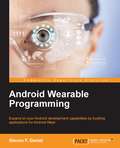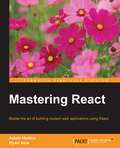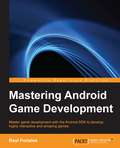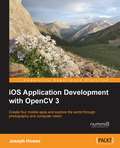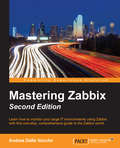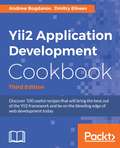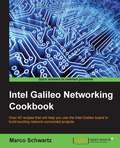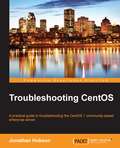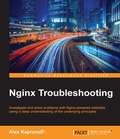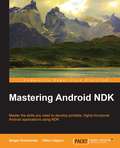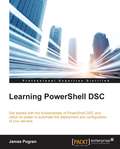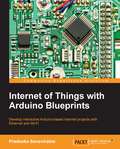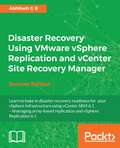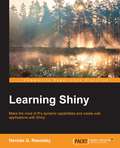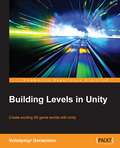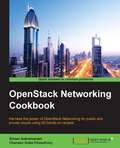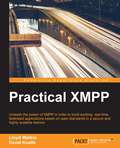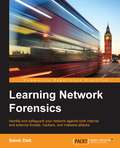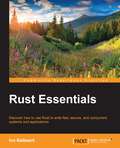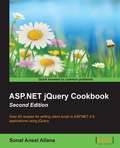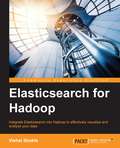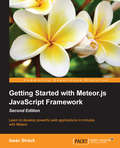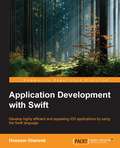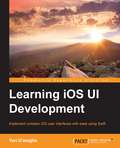- Table View
- List View
Android Wearable Programming
by Steven F. DanielIf you are an Android developer who wants to learn how to build applications for the Android Wear platform, then this is the book for you. This book only requires a basic knowledge of Android programming. Familiarity with development IDEs such as Android Studio, IntelliJ IDEA, or Eclipse will be helpful.
Mastering React
by Ryan Vice Adam HortonMaster the art of building modern web applications using React About This Book * Write a complete application in React using an array of supporting libraries, both specifically React-related and general purpose * Understand what makes React stand apart from the vast majority of JS frameworks available through detailed explanations and concise examples * Explore the React ecosystem and how to integrate React with other modern web technologies Who This Book Is For This book is ideal for web developers possessing strong core JavaScript fundamentals who are also interested in learning what React brings to the architectural table. Previous experience with React or other web frameworks isn't required, but may help. What You Will Learn * Understand the React component lifecycle and core concepts such as props and states * Craft forms and implement form validation patterns using React * Explore the anatomy of a modern single-page web application * Develop an approach for choosing and combining web technologies without being paralyzed by the options available * Create a complete single-page application * Start coding with a plan using an application design process * Add to your arsenal of prototyping techniques and tools * Make your React application feel great using animations In Detail React stands out in the web framework crowd through its approach to composition. This approach yields blazingly fast rendering capabilities. This book will help you understand what makes React special. It starts with the fundamentals and uses a pragmatic approach, focusing on clear development goals. You'll learn how to combine many web technologies surrounding React into a complete set for constructing a modern web application. With this text, you'll blitz the basics then swiftly move on to advanced topics such as form validation and complete application construction. You'll also explore several design activities which will help you develop your web applications with a thoughtful plan. Finally, you'll learn several methods for implementing slick animations using React. Style and approach This is a comprehensive, hands-on guide that helps you get a solid understanding of the ins and outs of React development. For application development, you will get a high view of the anatomy where you will zoom into each part and make decisions by moving through the application's anatomy; selecting a solution that fits the problem and lines up with your goals.
Mastering Android Game Development
by Raul PortalesIf you are an intermediate-level Android developer who wants to create highly interactive and amazing games with the Android SDK, then this book is for you.
iOS Application Development with OpenCV 3
by Joseph HowseCreate four mobile apps and explore the world through photography and computer vision About This Book * Efficiently harness iOS and OpenCV to capture and process high-quality images at high speed * Develop photographic apps and augmented reality apps quickly and easily * Detect, recognize, and morph faces and objects Who This Book Is For If you want to do computational photography and computer vision on Apple's mobile devices, then this book is for you. No previous experience with app development or OpenCV is required. However, basic knowledge of C++ or Objective-C is recommended. What You Will Learn * Use Xcode and Interface Builder to develop iOS apps * Obtain OpenCV's standard modules and build extra modules from source * Control all the parameters of the iOS device's camera * Capture, save, and share photos and videos * Analyze colors, shapes, and textures in ordinary and specialized photographs * Blend and compare images to create special photographic effects and augmented reality tools * Detect faces and morph facial features * Classify coins and other objects In Detail iOS Application Development with OpenCV 3 enables you to turn your smartphone camera into an advanced tool for photography and computer vision. Using the highly optimized OpenCV library, you will process high-resolution images in real time. You will locate and classify objects, and create models of their geometry. As you develop photo and augmented reality apps, you will gain a general understanding of iOS frameworks and developer tools, plus a deeper understanding of the camera and image APIs. After completing the book's four projects, you will be a well-rounded iOS developer with valuable experience in OpenCV. Style and approach The book is practical, creative, and precise. It shows you the steps to create and customize five projects that solve important problems for beginners in mobile app development and computer vision. Complete source code and numerous visual aids are included in each chapter. Experimentation is an important part of the book. You will use computer vision to explore the real world, and then you will refine the projects based on your findings.
Mastering Zabbix - Second Edition
by Andrea Dalle VaccheLearn how to monitor your large IT environments using Zabbix with this one-stop, comprehensive guide to the Zabbix world About This Book * Create a tailor-made monitoring solution based on your specific needs * Learn advanced techniques of Zabbix to monitor networks, performances, and other critical features in large environments * Integrate, customize, and extend your monitoring solutions with external components and software Who This Book Is For This book is intended for system administrators and IT architects who need to better integrate their Zabbix installation with their surrounding environment. A basic, working knowledge of Zabbix and Linux is assumed so that the book can focus on how to use every component to its full advantage. It will also be helpful to be familiar with programming concepts and languages but if not, all the content in the book is thorough and well documented. What You Will Learn * Efficiently collect data from a large variety of monitoring objects * Organize your data in graphs, charts, maps, and slide shows * Build intelligent triggers and alarms to monitor your network proactively * Write your own custom probes and monitoring scripts to extend Zabbix * Configure Zabbix and its database to be high available and fault-tolerant * Automate repetitive procedures using Zabbix's API * Integrate Zabbix with external systems * Understand the protocol and how to interact with it by writing your own custom agent In Detail Nowadays monitoring systems play a crucial role in any IT environment. They are extensively used to not only measure your system's performance, but also to forecast capacity issues. This is where Zabbix, one of the most popular monitoring solutions for networks and applications, comes into the picture. With an efficient monitoring system in place you'll be able to foresee when your infrastructure runs under capacity and react accordingly. Due to the critical role a monitoring system plays, it is fundamental to implement it in the best way from its initial setup. This avoids misleading, confusing, or, even worse, false alarms which can disrupt an efficient and healthy IT department. This new edition will provide you with all the knowledge you need to make strategic and practical decisions about the Zabbix monitoring system. The setup you'll do with this book will fit your environment and monitoring needs like a glove. You will be guided through the initial steps of choosing the correct size and configuration for your system, to what to monitor and how to implement your own custom monitoring component. Exporting and integrating your data with other systems is also covered. By the end of this book, you will have a tailor-made and well configured monitoring system and will understand with absolute clarity how crucial it is to your IT environment. Style and approach This book is an easy to follow, step-by-step guide to monitoring network and performance in large environments with Zabbix. It is designed for real-world Zabbix administrators, and is comprised of a perfect mix of theoretical explanations and practical applications, making it your perfect companion.
Yii2 Application Development Cookbook - Third Edition
by Alexander Makarov Dmitry Eliseev Andrew BogdanovDiscover 100 useful recipes that will bring the best out of the Yii2 framework and be on the bleeding edge of web development today About This Book * Learn how to use Yii2 efficiently through clear examples and core features, and see how to use tests, create reusable code snippets, core widgets, deployment, and more * This book provides you with a wide space for practice approaches and helps you to learn about the new Yii2 framework. * Understand the difference between the Yii 1.x.x versions using useful examples from real web applications Who This Book Is For This book is for developers with good PHP5 knowledge and MVC-frameworks who have tried to develop applications using the Yii 1.x.x version. This book will very useful for all those who would like to try Yii2, or those who are afraid to move from Yii 1.x.x. to Yii2. If you have still not tried Yii2, this book is definitely for you! What You Will Learn * See the new version of the Yii2 framework and application development practices * Write your applications more efficiently using shortcuts, Yii's core functionality, and the best practices in Web 2.0 * Get data from a database, and deal with Active Record, migrations, widgets, and core features * Easily update your skills from the previous version of the framework * Explore how to use Yii with different JavaScript frameworks and libraries such as WebSockets, Angular, Ember, Backbone and React * Learn how to keep your application secure according to the general web application security principle "filter input, escape output. * Write RESTfull Web Services using Yii2 and built-in features * Correctly install and use official extensions in your projects * Effectively create and implement your own Yii extension, and also ensure your extension is reusable and useful for the community In Detail Yii is a free, open source web application development framework written in PHP5 that promotes clean DRY design and encourages rapid development. It works to streamline your application development time and helps to ensure an extremely efficient, extensible, and maintainable end product. Being extremely performance optimized, Yii is a perfect choice for any size project. However, it has been built with sophisticated, enterprise applications in mind. You have full control over the configuration from head-to-toe (presentation-to-persistence) to conform to your enterprise development guidelines. It comes packaged with tools to help test and debug your application, and has clear and comprehensive documentation. This book is a collection of Yii2 recipes. Each recipe is represented as a full and independent item, which showcases solutions from real web-applications. So you can easily reproduce them in your environment and learn Yii2 fast and without tears. All recipes are explained with step-by-step code examples and clear screenshots. Yii2 is like a suit that looks great off the rack, but is also very easy to tailor to fit your needs. Virtually every component of the framework is extensible. This book will show how to use official extensions, extend any component, or write a new one. This book will help you create modern web applications quickly, and make sure they perform well using examples and business logic from real life. You will deal with the Yii command line, migrations, and assets. You will learn about role-based access, security, and deployment. We'll show you how to easily get started, configure your environment, and be ready to write web applications efficiently and quickly. Style and approach The chapters of this book are independent and offer a practical approach to Yii development. You can start reading from the chapter you need most, be it Ajax and jQuery, RESTful Web Services, Database, Active Record, or Official Extensions
Intel Galileo Networking Cookbook
by Marco SchwartzOver 50 recipes that will help you use the Intel Galileo board to build exciting network-connected projects About This Book * Create networking applications using the Intel Galileo board * Control your web-based projects in real time from anywhere in the world * Connect to the Temboo web service to interact with a huge range of APIs Who This Book Is For If you have already worked on ARM boards like Arduino, but now want to learn Intel Galileo, then this book is for you. Knowledge of C programming language is required. What You Will Learn * Set up your Galileo board for the Internet of Things * Connect external sensors to the Intel Galileo * Create and run a web server on the Galileo board * Control hardware devices from the Galileo * Host web-based applications on the Intel Galileo * Monitor data from the cloud using the Galileo * Build a complete home automation hub using the Galileo board In Detail Arduino is an electronic prototyping platform used by millions of people around the world. Intel Galileo is fully Arduino compatible; hence it combines the high performance of Intel with the simplicity of Arduino Software Development Environment. This makes it the ideal platform to build exciting projects, especially in the field of web-based connected applications and the Internet of Things. The book features several recipes all based on the Intel Galileo board, and that exploit the powerful features of the board. Each chapter explores a given field using the Galileo board. The book is mainly divided in three parts. The first part is all about learning the basics of the Intel Galileo board, but it uses some of the powerful features of the board such as connecting external sensors and complex hardware devices, compared with more basic Arduino boards. Then, the book dives into the topics related to networking and the Internet of Things. You will learn how to run a web server on the board and log data using a cloud-based service. Finally, the book ends with a chapter that aims to build a complete home automation hub using the Galileo board. This chapter uses everything that was learned in the book to make a home automation system using the Galileo board and Arduino. Style and approach This book contains exciting recipes that will help you create projects using the Intel Galileo platform to build systems in various domains like local networking applications, the Internet of Things, and home automation. Each recipe is explained in a step-by-step fashion, always starting with the assembly of the hardware, followed by basics tests of all hardware components. At the end, an exciting project is built using the knowledge acquired in the rest of the book.
Troubleshooting CentOS
by Jonathan HobsonIt is assumed that you will already have a server up and running, you have a good working knowledge of CentOS, and you are comfortable with the concept of working with those services used by your server.
Nginx Troubleshooting
by Alex KapranoffInvestigate and solve problems with Nginx-powered websites using a deep understanding of the underlying principles About This Book * Solve problems with your Nginx-powered websites before your audience notices anything * Peek into the Nginx architecture and gain knowledge that will help you be valuable to you in the long run * Gain knowledge of different types of problems in a step-by-step way Who This Book Is For The book is for technical specialists who already use Nginx to serve web pages for their users. Whether you are an experienced system administrator or a new professional, this book will help you do your job in the most efficient way. What You Will Learn * Detect and investigate problems with your web servers * Create correct and professional configuration files * Get an in-depth understanding of the web server software * Interpret Nginx log files easily and with actionable insights * Make your websites respond as fast as possible * Prevent problems by setting up proper monitoring and alerts In Detail Nginx is clearly winning the race to be the dominant software to power modern websites. It is fast and open source, maintained with passion by a brilliant team. This book will help you maintain your Nginx instances in a healthy and predictable state. It will lead you through all the types of problems you might encounter as a web administrator, with a special focus on performance and migration from older software. You will learn how to write good configuration files and will get good insights into Nginx logs. It will provide you solutions to problems such as missing or broken functionality and also show you how to tackle performance issues with the Nginx server. A special chapter is devoted to the art of prevention, that is, monitoring and alerting services you may use to detect problems before they manifest themselves on a big scale. The books ends with a reference to error and warning messages Nginx could emit to help you during incident investigations. Style and approach This comprehensive tutorial on Nginx troubleshooting takes an practical approach to guiding you through common issues in Nginx server.
Mastering Android NDK
by Viktor Latypov Sergey KosarevskyMaster the skills you need to develop portable, highly-functional Android applications using NDK About This Book * Develop portable games using Android NDK and debug them on your desktop * Familiarise yourself with different popular C++ libraries on Android and use them in your games * Write multi-threaded code with graphics, sound, networking, and resource storage Who This Book Is For If you want to leverage your C++ skills in mobile development and increase the performance of your Android applications, then this is the book for you. Knowledge of C or C++ is assumed, including pointer manipulation, multi-threading, object-oriented programming concepts, and the basics of C++11. It would be an added advantage if you know how to develop applications without any IDE. What You Will Learn * Explore different popular C++ libraries and import some of them to Android * Write portable, multithreaded native code * Create applications that play audio with OpenAL * Implement gesture recognition in your games and applications * Debug mobile applications on your desktop * Extract resources from APK archives * Render text with FreeType and also use OpenGL ES In Detail Android NDK is used for multimedia applications that require direct access to system resources. NDK is also the key for portability, which in turn allows a reasonably comfortable development and debugging process using familiar tools such as GCC and Clang toolchains. This is a hands-on guide to extending your game development skills with Android NDK. The book takes you through many clear, step-by-step example applications to help you further explore the features of Android NDK and some popular C++ libraries and boost your productivity by debugging the development process. Through the course of this book, you will learn how to write portable multi-threaded native code, use HTTP networking in C++, play audio files, use OpenGL ES 3, and render high-quality text. Each chapter aims to take you one step closer to building your application. By the end of this book, you will be able to create an engaging, complete gaming application. Style and approach This book adopts a step-by-step approach and each chapter is based on the material from the previous ones. The book focuses on putting to your knowledge of C++ use while you develop Android applications of your own.
Learning PowerShell DSC
by James PogranGet started with the fundamentals of PowerShell DSC and utilize its power to automate deployment and configuration of your serversAbout This BookCreate flexible and maintainable deployments using DSC configuration scripts that stand the test of timeExplore the in depth details of the core architecture, concepts, and practices used by PowerShell DSCA step-by-step guide that shows you how to start using and taking advantage of PowerShell DSCWho This Book Is ForThis book is intended for system administrators, developers, or engineers who are responsible for configuration management and automation and wish to learn PowerShell Desired State Configuration for efficient management, configuration and deployment of systems and applications.What You Will LearnUnderstand configuration management and why you need itCraft flexible, reusable, and maintainable configuration scripts for thousands of serversCreate custom DSC resources to manage any application or server settingApply configuration data to deploy applications to different environmentsUtilize DSC push deployments to test your configuration scripts and custom DSC resourcesInstall, configure and use DSC pull serversRun a Windows MSI packageDeploy a websiteIn DetailWindows PowerShell is a task-based command-line shell and scripting language designed especially for system administration. PowerShell DSC is a new management platform that enables you to deploy and manage configuration data for software services and manage the environment in which these services run.This book begins with an overview of the basics of PowerShell DSC by covering the architecture and components of the Desired Sate Configuration. It will then familiarize you with the set of PowerShell language extensions and new PowerShell commands. It will help you understand and create DSC configurations with the help of practical examples, and to create DSC custom resources for your custom applications. Finally, you will learn to deploy a real world application using PowerShell DSC. By the end of the book, you will have better knowledge about the powerful Desired State Configuration platform, which helps you to achieve continuous delivery, and efficient management and easy deployment of data for systems.Style and approachThis book is an in-depth guide to using PowerShell DSC, full of real-world experiences and best practices using PowerShell DSC. The topics are explained and build on one another other to provide a holistic learning experience. At the end, all the features learned will be used to create a real world application deployment using DSC.
Internet of Things with Arduino Blueprints
by Pradeeka SeneviratneDevelop interactive Arduino-based Internet projects with Ethernet and WiFiAbout This BookBuild Internet-based Arduino devices to make your home feel more secureLearn how to connect various sensors and actuators to the Arduino and access data from InternetA project-based guide filled with schematics and wiring diagrams to help you build projects incrementallyWho This Book Is ForThis book is intended for those who want to learn more about Arduino and make Internet-based interactive projects with Arduino. If you are an experienced software developer who understands the basics of electronics, then you can quickly learn how to build the Arduino projects explained in this book.What You Will LearnMake a powerful Internet controlled relay with an embedded web server to monitor and control your home electrical appliancesBuild a portable Wi-Fi signal strength sensor to give haptic feedback about signal strength to the userMeasure water flow speed and volume with liquid flow sensors and record real-time readingsSecure your home with motion-activated Arduino security cameras and upload images to the cloudImplement real-time data logging of a solar panel voltage with Arduino cloud connectorsTrack locations with GPS and upload location data to the cloudControl a garage door light with your Twitter feedControl infrared enabled devices with IR remote and ArduinoIn DetailArduino is a small single-chip computer board that can be used for a wide variety of creative hardware projects. The hardware consists of a simple microcontroller, board, and chipset. It comes with a Java-based IDE to allow creators to program the board. Arduino is the ideal open hardware platform for experimenting with the world of the Internet of Things. This credit card sized Arduino board can be used via the Internet to make more useful and interactive Internet of things projects.Internet of Things with Arduino Blueprints is a project-based book that begins with projects based on IoT and cloud computing concepts. This book covers up to eight projects that will allow devices to communicate with each other, access information over the Internet, store and retrieve data, and interact with users--creating smart, pervasive, and always-connected environments. It explains how wired and wireless Internet connections can be used with projects and the use of various sensors and actuators. The main aim of this book is to teach you how Arduino can be used for Internet-related projects so that users are able to control actuators, gather data from various kinds of sensors, and send and receive data wirelessly across HTTP and TCP protocols.Finally, you can use these projects as blueprints for many other IoT projects and put them to good use. By the end of the book, you will be an expert in the use of IoT with Arduino to develop a set of projects that can relate very well to IoT applications in the real world.Style and approachEvery chapter in this book clearly explains how to assemble components through easy-to-follow steps on while laying out important concepts, code snippets, and expected output results so that you can easily end up with a successful project where you can also enhance or modify the project according to your requirements.
Disaster Recovery Using VMware vSphere Replication and vCenter Site Recovery Manager - Second Edition
by Abhilash G BLearn to bake in disaster recovery readiness for your vSphere Infrastructure using vCenter SRM 6.1, leveraging array-based replication and vSphere Replication 6.1 About This Book * This is the first book on the market that provides an extensive disaster recovery solution using the latest vSphere Replication and vCenter Site Recovery Manager * Master the skills of protecting your virtual machines by replicating and recovering them in seconds * This practical, step-by-step guide will help you protect all your applications with Site Recovery Manager and Replication Who This Book Is For If you are a system administrator who is looking for a disaster recovery solution using the latest VMware vSphere Replication and vCenter Site Recovery Manager, this book is perfect for you. You should have a basic knowledge of virtual machines and data center operations. What You Will Learn * Familiarize yourself with disaster recovery concepts and the architecture of vCenter Site Recovery Manager and vSphere Replication. * Deploy and Configure vCenter Site Recovery Manager to leverage array-based replication and vSphere Replication. * Use vSphere Replication as a standalone disaster recovery solution. * Enabling protection of Virtual Machines by creating Protection Groups. * Enable orchestration of the recovery of protected virtual machines by creating Recovery Plans. * Migrate virtual machine workload from one site to another using Recovery Plans * Testing and Performing a failover or failback of Virtual Machines using Recovery Plans * Enable vRealize Orchestrator Plugins for SRM and vSphere Replication. In Detail VMware vCenter Site Recovery manage is an orchestration tool used to automate disaster recovery in a manner that no other solution does. It is programmed to leverage array-based replication and VMware's proprietary vSphere Replication engine. The book begins by talking about the architecture of SRM and guides you through the procedures involved in installing and configuring SRM to leverage array-based replication. You will then learn how to protect your virtual machines by creating Protection Groups and validate their recoverability by testing recovery plans and even performing failover and failback. Moving on, you will learn how to install and configure vSphere Replication as a standalone disaster recovery solution. It also guides you through the procedures involved in configuring SRM to leverage vSphere replication. Finally, you will learn how to deploy and configure vRealize Orchestrator and its plugin for SRM and vSphere Replication. Style and approach This is a practical, step-by-step guide on implementing a disaster recovery solution for your organization using VMware vSphere Replication and vCenter Site Recovery Manager.
Learning Shiny
by Hernan G ResnizkyIf you are a data scientist who needs a platform to show your results to a broader audience in an attractive and visual way, or a web developer with no prior experience in R or Shiny, this is the book for you.
Building Levels in Unity
by Volodymyr GerasimovThe book is aimed at game artists with no past programming experience who are interested in designing levels in Unity. It does not assume detailed knowledge of similar game platforms.
OpenStack Networking Cookbook
by Sriram Subramanian Chandan Dutta ChowdhuryThis book is aimed at network and system administrators who want to deploy and manage OpenStack-based cloud and IT infrastructure. If you have basic knowledge of OpenStack and virtualization, this book will help you leverage the rich functionality of OpenStack Networking in your cloud deployments.
Practical XMPP
by Lloyd Watkin David KoelleUnleash the power of XMPP in order to build exciting, real-time, federated applications based on open standards in a secure and highly scalable fashion About This Book * Learn about the fundamentals of XMPP and be able to work with the core functionality both server-side and in the browser * Build a simple 1-to-1 chat (the "Hello World" of XMPP), explore multi-user chat, publish subscribe systems, and work with a decentralized social network * Author Lloyd Watkins is a member of the XMPP standards committee Who This Book Is For If you want to learn about the fundamentals of XMPP, be able to work with the core functionality both server-side and in the browser then this book is for you.No knowledge of XMPP is required, or of TCP/IP networking. It's important that you already know how to build applications of some form, and are looking get a better understanding of how to implement XMPP for one or more of its many uses. You should be interested in the decentralized web, know HTML, and likely know JavaScript and NodeJS. You will probably know JSON, and hopefully XML (this is the native output of XMPP). What You Will Learn * Install and configure an XMPP server and use it to connect from a traditional desktop client and send a message * Build a simple server-side application that will respond to messages from our logged in desktop client * Install and run XMPP-FTW, connect to the server from the browser, and handle incoming/outgoing messages * Connect to a multi-user chat room, send/receive stanzas, add a room password, join a protected room, set the room's subject, and change a user's affiliation * Get to grips with the publish-subscribe extension of XMPP and use it to build a pusher system that can make any website real-time * Build a simple XMPP component and create an extension for XMPP-FTW that allows you to use your own custom format * Build an XMPP version of the classic game "Pong" In Detail XMPP (eXtensible Messaging and Presence Protocol) is a messaging protocol that enables communication between two or more devices via the Internet. With this book, developers will learn about the fundamentals of XMPP, be able to work with the core functionality both server-side and in the browser, as well as starting to explore several of the protocol extensions. You will not only have a solid grasp of XMPP and how it works, but will also be able to use the protocol to build real-world applications that utilize the power of XMPP. By the end of this book, you will know more about networking applications in general, and have a good understanding of how to extend XMPP, as well as using it in sample applications. Style and approach Through a number of hands-on projects, this book shows you how to build usable applications that highlights a feature of XMPP.
Learning Network Forensics
by Samir DattIdentify and safeguard your network against both internal and external threats, hackers, and malware attacks About This Book * Lay your hands on physical and virtual evidence to understand the sort of crime committed by capturing and analyzing network traffic * Connect the dots by understanding web proxies, firewalls, and routers to close in on your suspect * A hands-on guide to help you solve your case with malware forensic methods and network behaviors Who This Book Is For If you are a network administrator, system administrator, information security, or forensics professional and wish to learn network forensic to track the intrusions through network-based evidence, then this book is for you. Basic knowledge of Linux and networking concepts is expected. What You Will Learn * Understand Internetworking, sources of network-based evidence and other basic technical fundamentals, including the tools that will be used throughout the book * Acquire evidence using traffic acquisition software and know how to manage and handle the evidence * Perform packet analysis by capturing and collecting data, along with content analysis * Locate wireless devices, as well as capturing and analyzing wireless traffic data packets * Implement protocol analysis and content matching; acquire evidence from NIDS/NIPS * Act upon the data and evidence gathered by being able to connect the dots and draw links between various events * Apply logging and interfaces, along with analyzing web proxies and understanding encrypted web traffic * Use IOCs (Indicators of Compromise) and build real-world forensic solutions, dealing with malware In Detail We live in a highly networked world. Every digital device--phone, tablet, or computer is connected to each other, in one way or another. In this new age of connected networks, there is network crime. Network forensics is the brave new frontier of digital investigation and information security professionals to extend their abilities to catch miscreants on the network. The book starts with an introduction to the world of network forensics and investigations. You will begin by getting an understanding of how to gather both physical and virtual evidence, intercepting and analyzing network data, wireless data packets, investigating intrusions, and so on. You will further explore the technology, tools, and investigating methods using malware forensics, network tunneling, and behaviors. By the end of the book, you will gain a complete understanding of how to successfully close a case. Style and approach An easy-to-follow book filled with real-world case studies and applications. Each topic is explained along with all the practical tools and software needed, allowing the reader to use a completely hands-on approach.
Rust Essentials
by Ivo BalbaertThis book is intended for software developers interested in systems level and application programming, and are looking for a quick entry into using Rust and understanding the core features of the framework. It is assumed that you have a basic understanding of Java, C#, Ruby, Python or JavaScript.
ASP.NET jQuery Cookbook - Second Edition
by Sonal Aneel AllanaOver 60 recipes for writing client script in ASP.NET 4.6 applications using jQuery About This Book * This is a step-by-step guide to solve common problems in ASP.NET applications * Easy-to-follow recipes to write client scripts effortlessly and quickly * A hands-on approach that will show you how to interface jQuery with ASP.NET websites and MVC Who This Book Is For This book is for ASP.NET developers who want to use jQuery to write client scripts for cross-browser compatibility. The book assumes no prior knowledge of ASP.NET or jQuery, and every recipe is self-contained and explained in an easy-to-follow manner. Familiarity with Visual Studio and MS SQL Server is preferred, but not compulsory. What You Will Learn * Download and include jQuery in ASP.NET websites and MVC * Use jQuery selectors with ASP.NET server controls * Get to know about event handling and DOM traversal * Deploy jQuery for visual effects and animations * Develop AJAX-enabled ASP.NET applications * Create your own plugins * Solve common problems using less code and cut down your development time In Detail jQuery is a lightweight JavaScript library that has changed the landscape of client scripting in web applications. Developed by John Resig in 2006, it has taken the web by storm because of its cross-browser compatibility and the ability to get more done with less code. It has gained popularity with ASP.NET developers and is now distributed with Visual Studio and the NuGet package manager. ASP.NET jQuery Cookbook explores the wide range of utilities that the jQuery library provides. It teaches you the nitty-gritty of plugging in these features in ASP.NET web applications. It covers every aspect of interfacing the library, right from downloading and including jQuery on web pages to selecting controls, handling events, and creating animations. This book also walks you through DOM traversal and manipulation in ASP.NET and then through visual effects and graphics in ASP.NET sites. It explores advanced features such as posting AJAX requests and writing plugins. It will provide you with all the information you need to use this library confidently with ASP.NET. Style and approach This book takes a hands-on, pragmatic approach to solving common problems in ASP.NET applications using jQuery. Every recipe has detailed steps with screen captures and code snippets. The necessary theoretical concepts are introduced as and when needed.
Elasticsearch for Hadoop
by Vishal ShuklaIntegrate Elasticsearch into Hadoop to effectively visualize and analyze your dataAbout This BookBuild production-ready analytics applications by integrating the Hadoop ecosystem with ElasticsearchLearn complex Elasticsearch queries and develop real-time monitoring Kibana dashboards to visualize your dataUse Elasticsearch and Kibana to search data in Hadoop easily with this comprehensive, step-by-step guideWho This Book Is ForThis book is targeted at Java developers with basic knowledge on Hadoop. No prior Elasticsearch experience is expected.What You Will LearnSet up the Elasticsearch-Hadoop environmentImport HDFS data into Elasticsearch with MapReduce jobsPerform full-text search and aggregations efficiently using ElasticsearchVisualize data and create interactive dashboards using KibanaCheck and detect anomalies in streaming data using Storm and ElasticsearchInject and classify real-time streaming data into ElasticsearchGet production-ready for Elasticsearch-Hadoop based projectsIntegrate with Hadoop eco-system such as Pig, Storm, Hive, and SparkIn DetailThe Hadoop ecosystem is a de-facto standard for processing terra-bytes and peta-bytes of data. Lucene-enabled Elasticsearch is becoming an industry standard for its full-text search and aggregation capabilities. Elasticsearch-Hadoop serves as a perfect tool to bridge the worlds of Elasticsearch and Hadoop ecosystem to get best out of both the worlds. Powered with Kibana, this stack makes it a cakewalk to get surprising insights out of your massive amount of Hadoop ecosystem in a flash.In this book, you'll learn to use Elasticsearch, Kibana and Elasticsearch-Hadoop effectively to analyze and understand your HDFS and streaming data.You begin with an in-depth understanding of the Hadoop, Elasticsearch, Marvel, and Kibana setup. Right after this, you will learn to successfully import Hadoop data into Elasticsearch by writing MapReduce job in a real-world example. This is then followed by a comprehensive look at Elasticsearch essentials, such as full-text search analysis, queries, filters and aggregations; after which you gain an understanding of creating various visualizations and interactive dashboard using Kibana. Classifying your real-world streaming data and identifying trends in it using Storm and Elasticsearch are some of the other topics that we'll cover. You will also gain an insight about key concepts of Elasticsearch and Elasticsearch-hadoop in distributed mode, advanced configurations along with some common configuration presets you may need for your production deployments. You will have "Go production checklist" and high-level view for cluster administration for post-production. Towards the end, you will learn to integrate Elasticsearch with other Hadoop eco-system tools, such as Pig, Hive and Spark.Style and approachA concise yet comprehensive approach has been adopted with real-time examples to help you grasp the concepts easily.
Amazon EC2 Cookbook
by Aurobindo Sarkar Sekhar Reddy MandapatiThis book is targeted at Cloud-based developers who have prior exposure to AWS concepts and features. Some experience in building small applications and creating some proof-of-concept applications is required.
Getting Started with Meteor.js JavaScript Framework - Second Edition
by Isaac StrackThis book is for developers or students who have a working knowledge of JavaScript and HTML, and want to learn how to quickly develop full-stack web applications using pure JavaScript.
Application Development with Swift
by Hossam GhareebIf you are iOS developer with experience in Objective-C, and wish to develop applications with Swift, then this book is ideal for you. Familiarity with the fundamentals of Swift is an added advantage but not a necessity.
Learning iOS UI Development
by Yari D'AregliaImplement complex iOS user interfaces with ease using Swift About This Book * Build compelling user interfaces that users will enjoy using the iOS UIKit framework * Make your iOS apps easily recognizable and familiar with the UIKit framework * Use this comprehensive, step-by-step guide to create a complete custom layout Who This Book Is For This easy-to-follow guide is perfect for beginner-level iOS developers who want to become proficient in user interface development. It would also be useful for experienced iOS developers who need a complete overview of this broad topic all in one place, without having to consult various sources. What You Will Learn * Understand the basic requirements to work with iOS user interfaces * Get to know about the UI tools, frameworks, and built-in components * Plot dynamic layout structures using Auto Layout * Shape and implement adaptive user interfaces for different screen sizes * Draw and animate your user interfaces using the CALayer and UIKit animations * Intercept and handle user touches to create user interface interactivity * Create and depict totally custom controls * Design with iOS through Core Graphics In Detail Through this comprehensive one-stop guide, you'll get to grips with the entire UIKit framework and in a flash, you'll be creating modern user interfaces for your iOS devices using Swift. Starting with an overview of the iOS drawing system and the available tools, you will then learn how to use these technologies to create adaptable layouts and custom elements for your applications. Next, you'll be introduced to other topics such as animation and code-drawing with Core Graphics, which will give you all the knowledge you need to create astonishing user interfaces. By the end of this book, you will have a solid foundation in iOS user interface development and will have gained valuable insights on the process of building firm and complex UIs. Style and approach This concise yet information-packed guide is full of step-by-step instructions and screenshots of real-life examples, delivered in a direct manner, to get you creating modern user interfaces for your iOS devices using SWIFT in no time.
